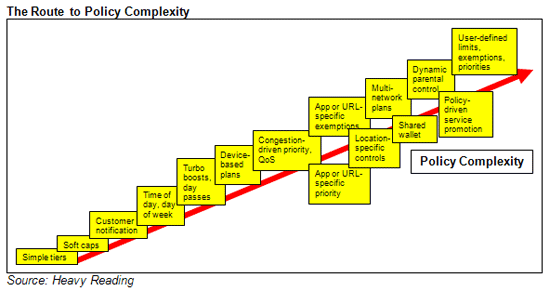 A new Heavy Reading report, by Graham Finnie (pictured), Chief Analyst, estimates that "the policy management market (including policy servers, policy enforcement gear such as DPI appliances, and ancillary elements) grew by almost 40 percent in 2010, and is set to become a $2 billion market within the next five years .. 15 companies have launched a policy server based on the 3GPP PCRF standard in the past three years, and our report reviews a whopping 40 companies that have some kind of policy proposition .. policies based on device, location, time of day, and prioritization or QoS based on application, URL or subscriber value have already been deployed by some operators as they seek to establish what kinds of mobile data service packaging will deliver the most value at the least cost"
A new Heavy Reading report, by Graham Finnie (pictured), Chief Analyst, estimates that "the policy management market (including policy servers, policy enforcement gear such as DPI appliances, and ancillary elements) grew by almost 40 percent in 2010, and is set to become a $2 billion market within the next five years .. 15 companies have launched a policy server based on the 3GPP PCRF standard in the past three years, and our report reviews a whopping 40 companies that have some kind of policy proposition .. policies based on device, location, time of day, and prioritization or QoS based on application, URL or subscriber value have already been deployed by some operators as they seek to establish what kinds of mobile data service packaging will deliver the most value at the least cost"Heavy Reading forecast of $2B for 2016 is lower compared to previous market forecasts (for example, Infonetics says that DPI and Policy servers will reach $2.1B and $1.6B, respectively, in 2015 - total of $3.7B - see other forecasts here).
This is explained by Heavy Reading analysis of the mobile market only, while other reports refer to the fixed market as well. Two years ago, the mobile market for DPI was nearly 0; recently DPI vendors say it is 50% of their revenues – so the trend seems to continue.
Key findings of Mobile Broadband & the Rise of Policy: Technology Review & Forecast include the following:
- The big increase in interest in deployment in the mobile sector has given a major revenue boost to the sector. We estimate that the global policy market, including PCRF, PCEF and ancillary revenues, grew by nearly 40 percent in 2010, to reach approximately $783 million.
 Our survey found strong interest in creating more sophisticated use cases that span the divide between traffic management and subscriber service design. This interest is beginning to translate into new and more complex use cases for policy. One widely deployed application is identifying and zero-rating access to Facebook within a quota-limited service.
Our survey found strong interest in creating more sophisticated use cases that span the divide between traffic management and subscriber service design. This interest is beginning to translate into new and more complex use cases for policy. One widely deployed application is identifying and zero-rating access to Facebook within a quota-limited service.
- Telcos identified problems integrating policy and charging as the single biggest barrier to deploying policy architectures. Solutions to these issues are thus likely to be well-received by customers, and there is much at stake here. However, there is some uncertainty here as a new interface (the Sy interface between PCRF and OCS/OFCS) emerges.
- The more demanding policy use cases that are now emerging will put pressure on vendors and may benefit those with the most powerful, flexible and well-integrated solutions. As policy becomes more sophisticated and widespread, it will require massive scaling up in the policy engine in terms of transactions or sessions handled, as well as better integration with other elements in the policy architecture.
See "Policy 2011: Hot, But Getting Crowded" - here and the executive summary - "Mobile Broadband & the Rise of Policy: Technology Review & Forecast" - here.




No comments:
Post a Comment